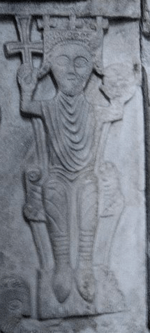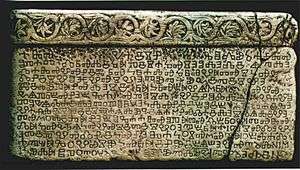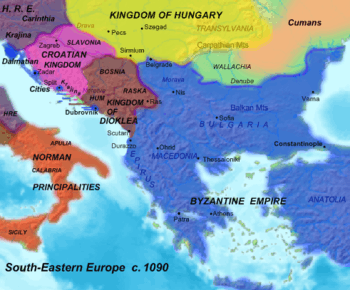Demetrius Zvonimir of Croatia
Demetrius Zvonimir (Croatian: Dmitar Zvonimir, pronounced [dmîtar zʋônimiːr]; died 1089) was King of Croatia and Dalmatia from 1076 until his death in 1089. He was crowned as king in Solin on 8 October 1076. Zvonimir also served as Ban of Croatia (1064–1074), and was named Duke of Croatia in around 1075. His native name was Zvonimir; he adopted the forename Demetrius at his coronation.
| Demetrius Zvonimir | |
|---|---|
 | |
| King of Croatia and Dalmatia | |
| Reign | 1076–1089 |
| Coronation | 8 October 1076 |
| Predecessor | Peter Krešimir IV |
| Successor | Stephen II |
| Died | 1089[i][3] Knin |
| Burial | Church of St. Bartholomew, Knin |
| Spouse | Helen of Hungary |
| Issue | Radovan Claudia Vinica |
| House | Trpimirović |
| Religion | Catholicism |
He first served as ban in the service of King Peter Krešimir IV. Afterwards, Peter Krešimir IV appointed him duke and declared him as his heir. In 1075, Demetrius Zvonimir succeeded to the Croatian throne through papal diplomacy.[4] His reign is characterized as relatively peaceful, with no extensive war campaigns; he focused instead on Croatia's economic and cultural development. He was the last native king who exerted any real power over the entire Croatian state, which he inherited at its height and ruled from the city of Knin. Medieval legends allege his assassination; his death and succession are subjects of controversy in Croatian historiography. His reign was followed by a period of anarchy, which ended with the ascension of the Hungarian Árpád dynasty and the creation of a union with Hungary.
Early years
Zvonimir's exact origin and background are uncertain. It is known that he had a magister (Latin for "teacher") named "Šestak", who also contributed to building monasteries around Croatia; that his maternal uncle was named Streza;[5] and that his family owned some estates near Biograd. Some historians have proposed that he is a descendant of Svetoslav Suronja, whose relatives fled Venice and sought refuge in Hungary. This allowed for the thesis that he began his career as Ban of Slavonia.[6]
Banates of Slavonia and Croatia
During the reign of King Peter Krešimir IV, his relative through the Orseoli family of Venice, it is conjectured that Zvonimir initially administered Slavonia, specifically the land between the rivers Drava and Sava, with the title of ban.[7] The term "Slavonia" (Latin: Sclavonia) at the time referred to both modern day Slavonia and North-West Croatia.[8]
The neighboring Holy Roman Empire under Henry IV invaded Hungary in 1063 to restore Solomon to the throne. Hungary was then ruled by Béla I, whose third daughter Helen was married to Zvonimir. According to Chronicon Pictum, Croatia was also attacked around 1067 by the Carantanian army of Ulric I, who occupied a part of Kvarner and eastern coast of Istria, the March of Dalmatia.[9] Since the Croatian king was preoccupied with rebellion in Dalmatia, due to the prohibition of Slavic liturgy,[6] Zvonimir was compelled to seek protection from Solomon, King of Hungary instead. Géza I and Solomon helped Zvonimir in restoring authority in the March of Dalmatia. After they jointly repelled the Carantanians from Croatia,[10] Ban Zvonimir sent gifts to Solomon as a sign of gratitude.[11] Shortly afterwards in 1070 Zvonimir is first mentioned as a Ban of Croatia in charters from Zadar, succeeding Gojko.[9][12] Croatian charters at the time were issued in the names of both King Peter Krešimir and Ban Zvonimir.[13] At the beginning of 1075, Zvonimir held title as "Duke of Croatia"; this gave him the rule of northern Dalmatia, and made him chief adviser to the reigning king and his heir. In that same year, Normans from southern Italy, led by Count Amico of Giovinazzo, invaded Croatia and captured a certain Croatian king whose name is not mentioned, most likely King Peter Krešimir, who died soon after.[6] About the middle of 1075, Zvonimir regained the allegiance of the coastal cities of Dalmatia which had been lost to the Normans.[14] Meanwhile, another contender for the throne, Stephen Trpimirović, who had also been the Duke of Croatia, relinquished his claim and relocated to the Church of Saint Stephen beneath the pines in the vicinity of Split, where he was to live a secluded life. This opened Zvonimir's path to the throne, with support from Pope Gregory VII.
Reign as king

Zvonimir was crowned on 8 October 1076[4] at Solin in the Basilica of Saint Peter and Moses (known today as the Hollow Church) by a representative of Pope Gregory VII (1073–1085).[15][16] Zvonimir took an oath of fealty to the Pope, promising to support the implementation of the Church reforms in Croatia. After his coronation, Zvonimir in 1076 gave the Benedictine monastery of Saint Gregory in Vrana to the Pope, both as a sign of loyalty and as accommodation for papal legates visiting Croatia.[17] The title of Zvonimir was "King of Croatia and Dalmatia" (Latin: Rex Chroatie atque Dalmatie), while his name and title in Croatian language, as found on the Baška tablet, was "Zvonimir, kral hrvatski" (English: Zvonimir, Croatian king), in Glagolitic script zvъnъmirъ, kralъ xrъvatъskъ. He took the Christian name of "Demetrius" at the coronation, most likely after the saint Pope Demetrius I of Alexandria.
Following Zvonimir's coronation, the papal legates summoned a church council in Split, which reiterated the ban on the use of Slavic language in liturgy and the condemnation of the Cyrillic alphabet, which the council of 1060 had branded as heresy.[18] The king instituted the Gregorian reform; he also promised the eventual abolition of slavery, but with little success (see Supetar cartulary). He maintained authority over Dalmatia, which could be felt as far as the distant town of Osor on island of Cres, where he is referenced in a 1082 lauda.[19] He continued the expansive and pro-Roman policies of his predecessor, maintaining a close alliance with the papacy. He made significant donations to the Archbishopric of Split whose head Lawrence had also been his personal advisor.

Demetrius Zvonimir sought to gain firmer control of his kingdom by ousting various local nobles (hereditary provincial leaders and landlords) from local administration and replacing them with his own supporters, court nobles and, reflecting his close papal ties, high clerics. The provincial nobles were governing their provinces (županije) with a significant level of internal independence.[20] In 1080, he bethrothed his daughter Klaudija to the noble Vonick of the Lapčani clan, to whom he also granted the county (županija) of Karin as a dowry.[19]
Around 1079, tensions arose between Croatia and the neighboring Holy Roman Empire, whose duke Vecelin (a sevant of emperor Henry IV) was preparing for an attack on Croatia from his estates in Istria. The pope intervened on behalf of Zvonimir, urging Vecelin to make any complaint to him directly regarding any issues with the king.[14] The Annales Carinthiæ and Chronica Hungarorum record that Zvonimir eventually invaded Carinthia to aid Hungary in war between 1079 and 1083, but this is disputed. Demetrius Zvonimir also took a hard line against the Byzantine Empire, but, unlike Peter Krešimir IV, he was also an ally of the Normans, with whom he joined in wars against Byzantium. When Robert Guiscard, Duke of Apulia, invaded the western Balkan provinces of the empire in 1084, Zvonimir sent troops to his aid.[21]
Death and succession

There are several versions of Zvonimir's death. The 13th century chronicler Thomas the Archdeacon and a charter of king Stephen II, said to have been issued closely after his death in 1089,[22] both assert that Zvonimir died of natural causes.[23][24] This view had been mostly accepted in modern historiography.[3] Various later sources give the date 20 April of the year 1089 as the date of his death. They also name the village of Kosovo (today's Biskupija near Knin) and the place by the basilica of Saint Cecillia as the place of death. These sources were typically associated with the allegations of his assassination, now believed to be a medieval legend.[25]
He was most likely initially buried in the church of St. Mary near his capital Knin,[14] while his remains were transferred to the nearby Kapitul in Knin, and were subsequently lost during the Ottoman conquest and destruction in the 16th century.
Demetrius Zvonimir was married to his distant relative Jelena, the sister of Ladislaus I of Hungary.[26] Through Helen, he was connected to the royal families of not only Hungary, but also Poland, Denmark, Bulgaria, and Byzantium. She bore him a son, Radovan, who predeceased him, and a daughter, Claudia, who was married to the vojvoda of Lapčani Lika. Since Zvonimir died without leaving an heir from his posterity;[23] he was succeeded by Stephen II, last of the House of Trpimirović. Stephen II ruled briefly until his death in 1091, at which point Ladislaus became the best candidate for the succession.
Croatia subsequently entered a period of anarchy, with various sides and nobles fighting over supremacy in the kingdom. The 14th century chronicle Chronicon Pictum narrates that, after Zvonimir's death, his widow had requested her brother Ladislaus to intervene.[27] Historia Salonitana instead claiming it was one of the Slavonian nobles that had approached and requested his intervention.
Legacy
Demetrius Zvonimir is viewed in contemporary Croatia as the last native king who held any real power and is regarded as one of the national heroes from the medieval period. The untimely death of his son, Radovan, and the short reign of Stephen II plunged Croatia into anarchy and resulted in a union with Hungary, which would last until 1918.
The culturally and historically significant Baška tablet was inscribed shortly after his death and contains references to him and a number of his nobles of the 11th century. For the first time, Baška tablet mentions the title of Croatian kings in Croatian: kral (kralj in modern Croatian).[28] His name is also contained in the 11th or 12th-century Jurandvor fragments from the same church in Baška, on the island of Krk.[29]
Legend about death
A 13th century Polish–Hungarian Chronicle is the earliest source to allege his murder. It justifies Ladislaus' conquest of Croatia as Zvonimir's avenger .[30]
Another account, from the Croatian redaction of the Chronicle of the Priest of Duklja, says that in 1089, desiring to heal the East-West Schism Pope Urban II asked Zvonimir, his strongest Balkan ally, to assist Alexios I Komnenos against the Seljuks. Zvonimir convened the Sabor at a place called "seven churches in Kosovo", which had been identified by the archaeologists as Biskupija near Knin.[31] His intention was to mobilize the army on behalf of the pope and the emperor, but the nobility refused him and a rebellion erupted, leading to Zvonimir's assassination at the hands of his own soldiers.[3]
Ivan Tomašić's Chronicon breve Regni Croatiae of 1563, in an otherwise identical account, names the assassin as the king's personal chaplain Tadija Slovinac, who entered the king's tent located by the Basillica of Saint Cecillia in Kosovo and killed him in his sleep upon the insistence of the population. Tomašić also records that his remains were located in the Church of Saint Bartholomew in Kapitul in the outskirts of Knin.[32]
Various other sources of the 16th century record similar events, among which an epitaph ascribed to his grave was recorded:[33]

Who could refrain the people, not to sigh,
when they watch this grave, truly worthy of sorrow?
Because in this darkness a bright star rests,
with sublime ancestry. How it oddly numbs!
Since its barbarous death can only be explained by cursing,
with dark crime of wicked folk,
where their fury relents until the heart eases
and with murder they take down the king,
very healthy, with much power,
the pious Zvonimir, distinctly fair and honest,
who was their shield against enemies,
used to crush the rival doors,
mourn, champions, already a leader plies,
old and young of Croatian land,
because what was first divination of the kingdom
and also honour and glory, is now in ruins.
His death marked the collapse of Croatian royal power. The myth of the "Curse of King Zvonimir" is based on the legend of his assassination.[3][34] Historian Johannes Lucius was the first to dismiss these claims in his 1673 historiographical work De regno Dalmatiae et Croatiae ("On the Kingdom of Dalmatia and Croatia").
Modern
"Zvonimir" is today a traditional and quite common Croatian name, meaning "sound, chime" (zvoni) and "peace, prestige" (mir),[35] King Zvonimir being the first recorded bearer of the name. The Grand Order of King Dmitar Zvonimir, which is awarded to high-ranking officials, is named after him, as well as many streets in Croatia. Croatian Navy's flagship and its most modern ship, RTOP-12 Kralj Dmitar Zvonimir, was also named after the late king.
 Monument in Knin,
Monument in Knin,- Zvonimir's vows by Celestin Medović,
 Coronation of Zvonimir by Ferdo Quiquerez, 1897
Coronation of Zvonimir by Ferdo Quiquerez, 1897
Family
In c. 1063 Zvonimir married Helen, daughter of Béla I of Hungary and his wife Richeza of Poland. They had three children:
See also
Notes
^ i: This is the date generally given when it comes to the theory of his assassination, as it was reported by many.
References
- https://hrcak.srce.hr/file/108952
- https://hrcak.srce.hr/file/137394
- Nemet, p. 89
- Dominik Mandić, Rasprave i prilozi iz stare hrvatske povijesti, Institute of Croatian history, Rome, 1963, pages 315, 438.
- Znameniti i zaslužni Hrvati: te pomena vrijedna lica u hrvatskoj povijesti od 925–1925, str. X, Odbor za izdanje knjige "Zaslužni i znamenti Hrvati 925–1925." Emilije Laszowski, Zagreb 1925.
- Neven Budak: Prva stoljeća Hrvatske, Hrvatska sveučilišna naklada, Zagreb 1994, p. 31-33
- http://arhinet.arhiv.hr/_DigitalniArhiv/Monumenta/HR-HDA-876-5.htm
- Ivo Goldstein (1995). Hrvatski rani srednji vijek. Zagreb: Novi Liber. pp. 389–390. ISBN 978-953-6045-02-0.
- Nada Klaić, Povijest Hrvata u ranom srednjem vijeku, Zagreb 1975., p. 377-379
- SS rerum hungaricarum I, p. 364 "Misit itaque rex Zolomerus Dalmacie, qui sororius Geyse erat, nuncios ad regem Salomonem et ducem Geysam, et rogavit eos, ut propria persona eorum contra adversarios suos, scilicet Carantanos ipsumadiuvarent, qui tunc marchiam Dalmacie occupaverant. Rex igitur et dux collecto exercitu iverunt inDalmatiam, et ablatam sibi restituerunt integre."
- Ferdo Šišić, Povijest Hrvata u vrijeme narodnih vladara, 1925, Zagreb ISBN 86-401-0080-2
- Codex Diplomaticus Regni Croatiæ, Dalamatiæ et Slavoniæ, Vol I, pages 115, 121, 129
- Fine, p. 279
- Ferdo Šišić, Povijest Hrvata; pregled povijesti hrvatskog naroda 600. – 1918., Zagreb ISBN 953-214-197-9
- Demetrius, Duke of Croatia and Dalmatia Archived 12 February 2006 at the Wayback Machine He was granted the royal title by Gregory after pledging "Peter's Pence" to the Pope.
- Tomislav Raukar Hrvatsko srednjovjekovlje, Školska knjiga, Zagreb, 1997. ISBN 953-0-30703-9, str. 49
- Curta, p. 262
- Curta, p. 263
- http://www.enciklopedija.hr/Natuknica.aspx?ID=67581
- Fine, p. 283
- http://crohis.com/knjige/horvat-povijest/4.hr-vlad.PDF
- Nemet pp. 74/75
- Archdeacon Thomas of Split: Historia Salonitana, 17, p. 93.
- Marcus Tanner, Croatia – a nation forged in war, Yale University Press, New Haven, 1997 ISBN 0-300-06933-2
- Nemet, pp. 78/84
- Trpimir Macan, Povijest hrvatskoga naroda, Zagreb, 1992.
- Nemet, pp. 77
- Baska tablet – Dr. sc. Mateo Zagar Archived 25 August 2004 at the Wayback Machine, svkri.hr; accessed 18 December 2015
- Glagoljski natpisi, JAZU (now HAZU, Hrvatska akademija znanosti i umjetnosti), Zagreb, 1982 pp. 62–65
- Nemet, pp. 79
- Gunjača, p. 154
- Nemet, pp. 82/83
- Nemet, pp. 80
- Damir K., The Šubići and the Good King Zvonimir. A Contribution to the Research on Use of Legends as a Means of Politics of Croatian Aristocratic Families, Zagreb 2000
- http://www.behindthename.com/name/zvonimir
- Monumenta Historiam Slavorum Meridionalium, Vol. VII, Acta, 51, p. 66.
- Codex Diplomaticus Croatiæ, Vol. I, CCXI, p. 177.
- Monumenta Historiam Slavorum Meridionalium, Vol. VII, Acta, 121, p. 146.
Literature
- Nemet, Dražen; Death of Croatian king Zvonimir – problem, sources and interpretation
- Gunjača, Stjepan; Ispravci i dopune u starijoj hrvatskoj historiji, Zagreb, Školska knjiga, 1973–1978
- John Van Antwerp Fine; The Early Medieval Balkans: A Critical Survey from the Sixth to the Late Twelfth Century, 1991
- Florin Curta; Southeastern Europe in the Middle Ages, 500–1250
External links
| Wikimedia Commons has media related to Demetrius Zvonimir of Croatia. |
- (in Croatian) August Šenoa – In the memorial of 800th anniversary of Zvonimir's coronation
- Zvonimir on Royal Croatia
- Arhinet – "rex Chrobatorum et Dalmatinorum, rex (tocius) Chroacie atque Dalmacie, Chroatorum atque Dalmatinorum rex"
Demetrius Zvonimir of Croatia House of Trpimirović Died: 20 April 1089 | ||
| Preceded by Peter Krešimir IV |
King of Croatia 1075–1089 |
Succeeded by Stephen II |
| Preceded by Gojko |
Ban of Croatia c.1065–1075 |
Succeeded by Petar |
